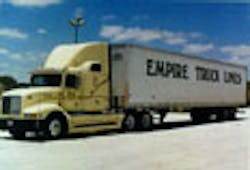The numbers are still getting worse when it comes to the truck driver shortage. During the first quarter this year, driver turnover for large truckload carriers increased to 127% – the highest turnover rate since the end of 2005. That means truckload carriers ended the quarter with 1.8% fewer drivers than it had at the start, according to the American Trucking Assns. (ATA)
Currently, the long-haul sector is experiencing a national shortage of 20,000 truck drivers, pointed out ATA chief economist Bob Costello. He said an aging workforce combined with a decline in the primary demographic group that comprises the bulk of the driver pool has left many fleets unable to seat trucks or add capacity. If current demographic trends continue, that shortage of long-haul truck drivers could increase to 111,000 by 2014.
That’s why, more than ever, many fleets believe they must forge tighter personal bonds with drivers, going well beyond simply offering them bigger paychecks.
“We call it a marriage between driver and company – we’re all family here,” Jim Jeter, gm of trucking operations at Houston-based Empire Truck Lines, explained to FleetOwner. “We also must understand how the driver population is changing, in terms of how they approach the job in relation to their family needs.”
Jeter, a driver himself for 20 years, puts drivers into two categories today: “Mossbacks,” the older drivers who have driven for a decade or more, and “X-ers,” who represent the younger generation.
“Each has a different work ethic; neither being bad, mind you, just different – but you must manage that difference,” he said. “In the past, a driver would put work first and family second, but he wanted to be home on weekends. Now, drivers put family first and work second – but they give you 110% at work and will settle for non-traditional days off, like in the middle of the week.”
Managing these differences is critical, said Jeter, because Empire can’t afford to be short drivers. Right now, the carrier leases 350 owner-operators but that’s only half of where it wants to be to cover demand for intermodal and regional freight. Ideally, he’d like to have 500 on the road for Empire.
“Owner-operators take a lot of pride in their business – they are professionals who know what they need to make a living,” he said. “But more than anything today, their reputation as a driver and our reputation as a carrier are vital. The days of just sticking a driver in a truck are over. We need to make sure they have the right equipment and the right expectations for the job or it won’t work.”
It also means being more proactive, stressed Jeter. For example, if a driver who regularly logs 3,000 miles a week suddenly drops to 1,800, or the reverse happens, a carrier needs to step in and see what’s going on.
“If their miles drop, are they having problems at home? Or if they suddenly increase their miles, do they have financial problems they need to address?” he said. “They key is to ask them if everything is all right before the problem gets too big. Even if there isn’t a problem, we try to talk to our drivers two times a day at the very least. It shows we care – that they are not just a number.”
Ultimately, said Jeter, the driver is the one generating the money that pays for everyone’s salary at the trucking company – and that’s something Empire never lets its staff forget.
“It’s all about relationships now,” he said. “If we take care of that driver, make sure they are getting the miles and home time they need, making sure they are well-respected, then we’ll be able to grow our business. In our view, it’s all about supporting the people that write our checks.”
About the Author
Sean Kilcarr
Editor in Chief
Sean Kilcarr is a former longtime FleetOwner senior editor who wrote for the publication from 2000 to 2018. He served as editor-in-chief from 2017 to 2018.
